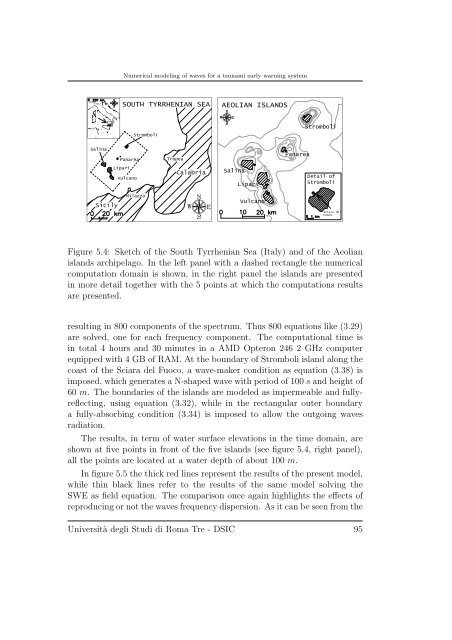Numerical modeling of waves for a tsunami early warning system
Numerical modeling of waves for a tsunami early warning system
Numerical modeling of waves for a tsunami early warning system
You also want an ePaper? Increase the reach of your titles
YUMPU automatically turns print PDFs into web optimized ePapers that Google loves.
<strong>Numerical</strong> <strong>modeling</strong> <strong>of</strong> <strong>waves</strong> <strong>for</strong> a <strong>tsunami</strong> <strong>early</strong> <strong>warning</strong> <strong>system</strong><br />
Figure 5.4: Sketch <strong>of</strong> the South Tyrrhenian Sea (Italy) and <strong>of</strong> the Aeolian<br />
islands archipelago. In the left panel with a dashed rectangle the numerical<br />
computation domain is shown, in the right panel the islands are presented<br />
in more detail together with the 5 points at which the computations results<br />
are presented.<br />
resulting in 800 components <strong>of</strong> the spectrum. Thus 800 equations like (3.29)<br />
are solved, one <strong>for</strong> each frequency component. The computational time is<br />
in total 4 hours and 30 minutes in a AMD Opteron 246 2 GHz computer<br />
equipped with 4 GB <strong>of</strong> RAM. At the boundary <strong>of</strong> Stromboli island along the<br />
coast <strong>of</strong> the Sciara del Fuoco, a wave-maker condition as equation (3.38) is<br />
imposed, which generates a N-shaped wave with period <strong>of</strong> 100 s and height <strong>of</strong><br />
60 m. The boundaries <strong>of</strong> the islands are modeled as impermeable and fullyreflecting,<br />
using equation (3.32), while in the rectangular outer boundary<br />
a fully-absorbing condition (3.34) is imposed to allow the outgoing <strong>waves</strong><br />
radiation.<br />
The results, in term <strong>of</strong> water surface elevations in the time domain, are<br />
shown at five points in front <strong>of</strong> the five islands (see figure 5.4, right panel),<br />
all the points are located at a water depth <strong>of</strong> about 100 m.<br />
In figure 5.5 the thick red lines represent the results <strong>of</strong> the present model,<br />
while thin black lines refer to the results <strong>of</strong> the same model solving the<br />
SWE as field equation. The comparison once again highlights the effects <strong>of</strong><br />
reproducing or not the <strong>waves</strong> frequency dispersion. As it can be seen from the<br />
Università degli Studi di Roma Tre - DSIC 95

















